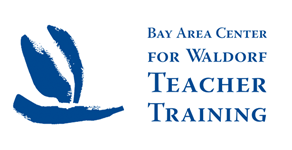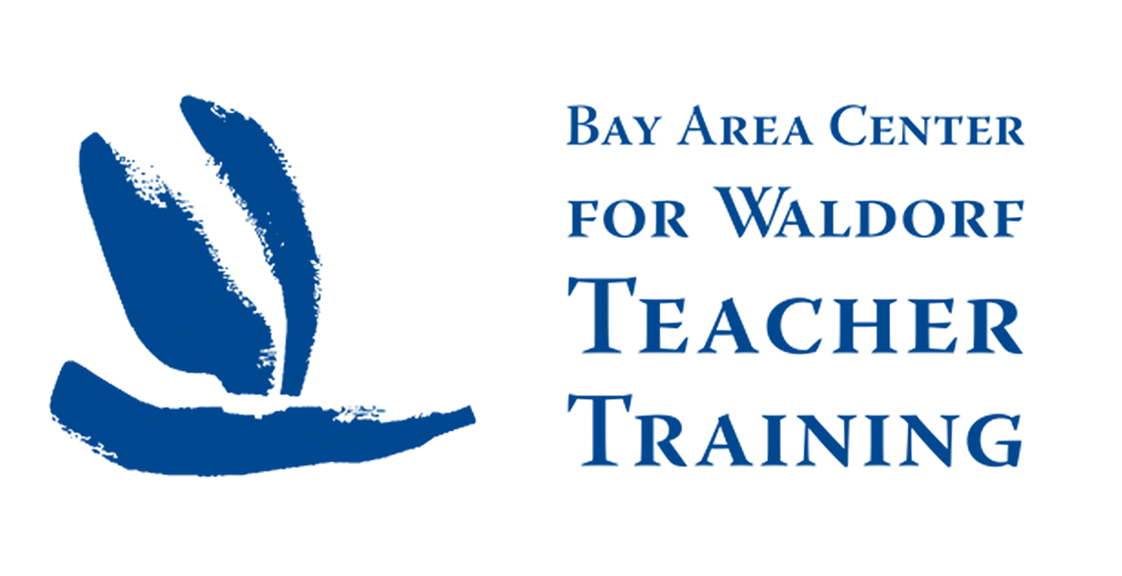Dear BACWTT Students, Alumni, Friends and Colleagues,
Here is the Calendar of the Soul verse for this week:
Verse 7
My self it threatens to take flight
By world’s clear light drawn mightily
Now my divining enter
With strength upon your rights,
Replace for me the power of thought,
Which in the senses glory
Inclines to lose itself.
The verse this week expresses a loss of the capacity for strong clear thought – and the wish for something else, “my divining,” to come to the rescue.
How many of us can recall a mood or feeling that we have every year at a certain time? Is the cycle of the year and our inner experience a surprise to us every year? Or do we remember, “Oh yes, that’s the same as last year, and the year before, and actually many times I have had that experience?”
This time of year for me has a flavor, a taste, and when it is at its best – for me – the flavor of a Shakespeare play! Of rehearsals with teenagers in small groups outside, under the trees. Of the dark and heat of the stage. Of the teacher barely able to keep it all together, but determined to push through on a wing and a prayer and a few extra cups of coffee..! And yet, in this loosened situation, we can sense something miraculous is at work, a process is underway. Critical moments and crises come and go, shaping the group and the performance to come. I know this is a personal experience but, for me, Shakespeare is the best for this. All of his plays that involve a loss of consciousness in nature, such as A Midsummer Night’s Dream and The Tempest, most deeply manifest this experience.
There is a reassurance in these plays that after the loss and confusion, and without the clear consciousness of the people involved, sanity and order will be restored. Greater powers are at work guiding human development – for the good – and, in the two plays mentioned above, even influencing the order of the non-human, fairy or elemental worlds.
I am sure there are Waldorf teachers who dread this time of year… and others who do well in the chaos and confusion, who don’t mind holding the reins of their horses lightly, trusting that the horse is not a dumb animal, but is intelligent in ways unknown to us. There is something in this experience that speaks to the expression in the verse, “Now my divining enter/With strength upon your rights/Replace for me the power of thought.”
There is a continuity of ancient knowledge and a foreknowing in the artistic works that mark the beginning of our era – the Consciousness Soul era – which, according to Rudolf Steiner, began in 1413 A.D. and will continue until 3573 A.D. (We are not yet 1/3 of the way into our particular evolutionary era.) As humanity began its journey into this era, the works of Shakespeare sound out themes that will continue to unfold – are unfolding now. There is something in the genius of these plays that allows a process to unfold, the transformation of the characters to take place, and a resolution to be found – all within this mood of “replace for me the power of thought.”
It is difficult to grasp, and more difficult to share, all of the ideas flowing through Waldorf education. There are so many, and they are complex, interwoven, layered. I had the pleasure of interviewing a new student for our program recently and explaining why we meet every weekend, and for 4 weeks in the summer, for 3 years. And one of the reasons is this – the layers. How can I explain the need to do Shakespeare with teenagers?
A Waldorf teacher training is not (only) a “how to teach” course; it is a course in geology, human geology and astronomy, human astronomy. Students in a Waldorf teacher training program need to be provided with a spade and a telescope, and shown how to dig into the layers of the soil of the human soul and how to gaze into the human constellations of space.
Otherwise, how can we ever sense that the odd English playwright with his strange, quaint English language and dated historical references has any relevance to us here today in California? That he actually encapsulated essential guiding principles for people in 2020? That we are in and living through a transformative Shakespearean Consciousness Soul event right now?
In a world that would reduce everything to molecules and atoms and gravity, and explain everything through mechanistic and animalistic forces of evolution, Rudolf Steiner walks on to the modern scene with a (metaphorical) spade and telescope! It is one of the profound tasks of those involved in Waldorf teacher training to ensure that these tools are handed down to the next generation of Waldorf teachers. These are the tools that are needed to comprehend ourselves and our time.
I would like to share with you an image closely related to this idea. I introduced it yesterday to 9th Grade students in my Art History class.
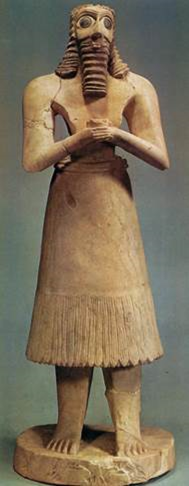
At first, it appears quite strange and out of proportion – the huge eyes, massive shoulders, tiny waist and tiny fingers, strong earthy legs and feet.
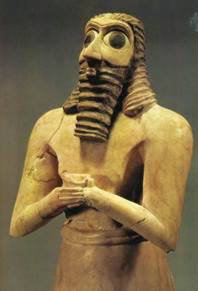
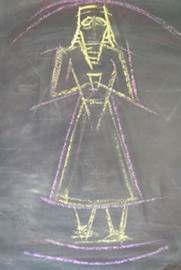
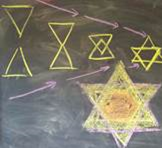
The sculpture is a devotional figure, carved in the shape of a prayer. The large open eyes look up to the sky, the massive feet and the shape of the skirt reach down to the earth. In the center, the midpoint of these two intersecting triangular gestures, the delicate hands hold a vessel in the hope of receiving a nourishing and nurturing gift. In other sculptures of these people, you can see streams of water flowing from the cup – the water of life.
When discussing this figure with the 9th Grade, one student was able to articulate why the hands and fingers might have been so small – to express the unique human intelligence that is shown through the things people can make with their hands, their fine motor skills, and that the delicacy of the hands expresses their choice, their control over their hands – that their deeds may be good and beneficial and acceptable to the gods.
Bringing Art History to students, as with many subjects both in the high school and the teacher training, has the effect of connecting us to human creations across time and continents. What does this strange figure from Iraq 4500 years ago have to do with me? Have to do with modern times?
Actually a lot! But we need that spade and telescope to figure it out!
In our BACWTT Whitsun Festival last Saturday, we deliberated the poem, “A Brave and Starling Truth” by Maya Angelou as well as an excerpt from The Work of the Angels in Man’s Astral Body by Rudolf Steiner.
There are a number of expressions that Maya Angelou uses regarding the human hands:
“When we release our fingers/From fists of hostility/And allow the pure air to calm our palms”
“Whose hands can strike with such abandon/That in a twinkling, life is sapped from the living/Yet those same hands can touch with such healing, irresistible tenderness”
Her poem bridges the time and cultural changes, as with the ancient Sumerians, so with us. How are we using our hands today? I have enjoyed watching many people on Zoom ending the call by waving goodbye with their hands. These same hands that have become so mechanized and automaton-like on the keyboard and mouse appear on the screen childlike and naïve, reaching across the digital space to wave goodbye like they must have done hundreds of thousands of years ago, reaching across an African plain or like children waving goodbye to their parents as they enter kindergarten.
So many of the things that we do in Waldorf education, while at the same time satisfying the need for academic knowledge and understanding, are serving this need for knowing our place in the scheme of things, knowing our time, sensing the special tasks and responsibilities we are being asked to attend to, paying attention to what is new and hopeful and to that which aims to drag the human being down – sensing what it will take to maintain humanness in our era.
When I look at the Sumerian figure, I am not sure if his effort is to hold the cup up – out of the forces of gravity – or to hold it down, so that it doesn’t drift up into the light. When we look at the figure with the focus on the rightful placement of the cup and the intelligence of the hands that keep it there, then the head and the feet reveal their extreme gestures.
In the words of Maya Angelou, “Out of such chaos, of such contradiction/We learn that we are neither devils nor divines.”
Ken
Kenneth Smith, Director; BACWTT
